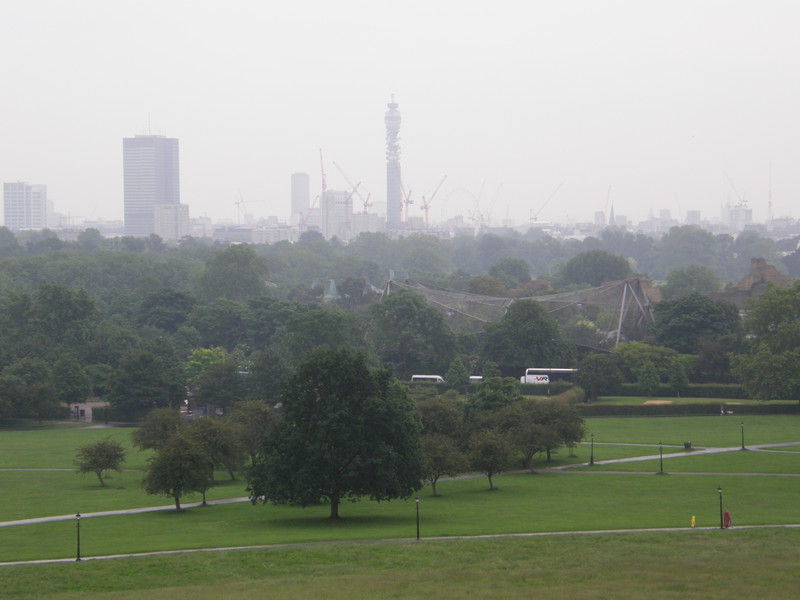
This is clearly going to be fun. I've been rained on, I've got a mysterious black stain up the side of my left leg, I've spent ages wandering around, hopelessly lost, at least twice, and I've still had a wonderful day's walking. London bodes well, much to my relief.
Some of this probably has to do with the fact that it's Monday and I'm not at work. There's something deeply satisfying about stepping out into the middle of a busy city, safe in the knowledge that the rush around you is no longer anything to do with you. It's a bit like being in one of those car or phone adverts, where the world blurs past in a mad hurry while a relaxed and slightly smug man in a knowing haircut strolls through the chaos, smiling at the rat race around him. I felt a bit like that as I stepped out of Aldgate station, if you ignore the bit about the haircut.
I soon managed to wipe the smugness off my own face by getting utterly lost within 30 seconds of starting my first tubewalk. As I was taking a photo of the Gherkin peeking over the buildings at the end of a small lane, I realised that no, it probably shouldn't be in that direction, but over there instead, and after a quick scramble with the map I realised that, yes, I was heading in the direction of Cornwall when I should have been heading for north Wales. It's an easy thing to do, particularly if you're the kind of alpha male who refuses to take directions and knows that yes, it's over there, just follow me. I'm no longer that kind of person, believe me...
Anyway, here are the highlights of my first tubewalk from Aldgate to Finchley Road, a very pleasant introduction to the world of tubewalking.
Aldgate to Liverpool Street
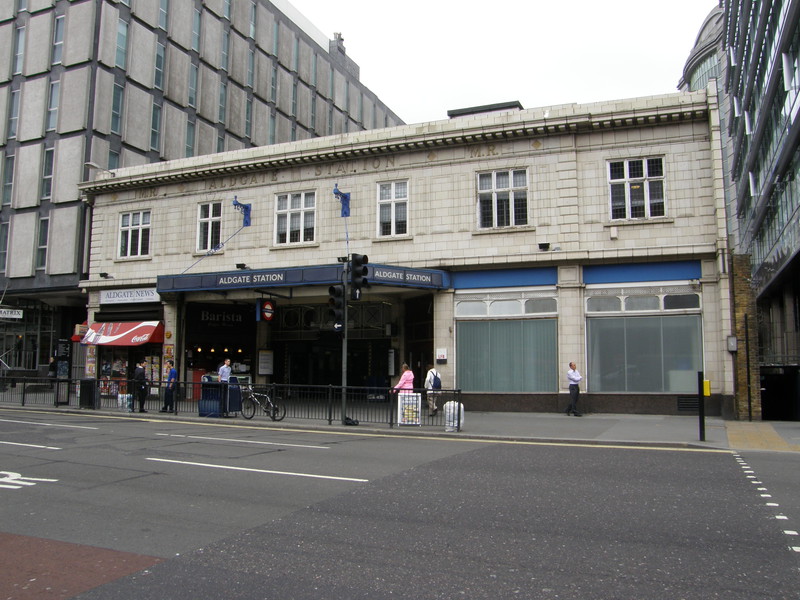
Aldgate station, opened on , feels like an old station; as you get off the train, daylight filters through the roof, an unusual feeling for a city-centre underground stop. The Metropolitan Railway, as the original underground line was called, was built using the cut-and-cover technique, so the lines are nowhere near as deep as the later Tube lines. Indeed, as you walk the Metropolitan line through the City, you can't help but notice the railway popping up here and there, in cuttings or below bridges. It truly is a subterranean railway, rather than a Tube line, and it's all the more charming for it; it feels Victorian, a bit a Heath Robinson even, and the thought that the trains ran on steam until 1905 makes it even more amazing. The Victorians were clearly something else.
From Aldgate to Liverpool Street, the feeling is of the ultra-modern rubbing shoulders with the rather ancient. The Gherkin and its siblings dominate the skyline, popping up at the ends of side streets and lending a gentle, curvy air to the more traditional office blocks. Devonshire Square comes as a pleasant surprise, a quiet, paved space with a circle of trees in its centre, sheltering some pleasant benches that no doubt fill up at lunchtime. I like these pockets of peace in the bustle; they're the walker's equivalent of the alcoholic's moment of clarity...
Liverpool Street to Moorgate
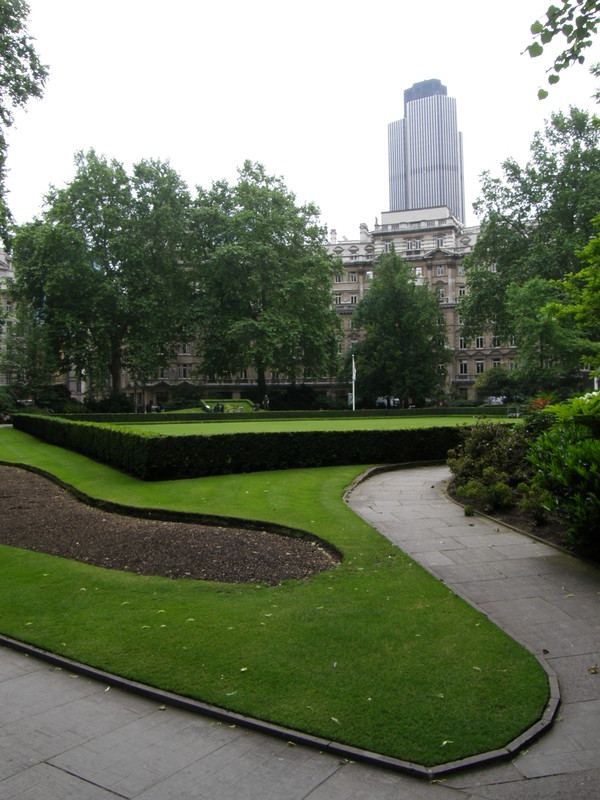
It isn't far from Devonshire Square to Liverpool Street station, though the 'Street' part of the sign has fallen off, so it's currently called Liverpool Underground Station. I presume this isn't a permanent change, though it wouldn't be the station's first name change, as it originally opened as Bishopsgate on before being renamed Liverpool Street in 1909.
Not far from Liverpool Street is pretty Finsbury Circus, an oval green space with a silky smooth crown green bowling green in the centre (home to the City of London Bowling Club, no less). To the south of the Circus was the site of Bethlem Royal Hospital from 1675 to 1815, the mental hospital that gave us the word 'Bedlam'. It's a somewhat more peaceful place these days, and no doubt a popular sandwich spot for lunching City folk, though at mid-morning it's more of a Mecca for workers popping out for a cigarette (and who can blame them?).
It's a quick stroll from Finsbury Circus to Moorgate station, on the other side of busy Moorgate. The station is a pleasant, red brick affair, dating from , and you can walk through the station to the other side, where there's yet another entrance opposite.
Moorgate to Barbican
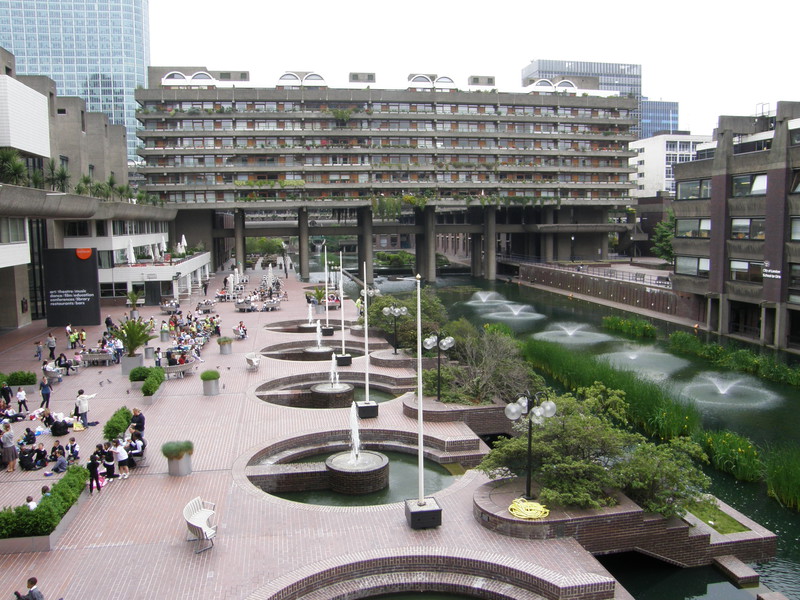
I didn't think it would be, but the Barbican turned out to be the highlight of my walk. Until today I've never explored the Barbican, assuming it was some bizarre post-war concrete experiment that was best avoided. How wrong I was! It's fascinating to wander around, and I got completely lost for the second time when I thought it might be a good idea to try to walk through the complex to the station on the other side. It's a complete maze, but it's great fun, particularly if you climb up a couple of floors to the high walkway that connects all the important bits. I got happily lost here for some time, and even the friendly librarian I asked for directions couldn't stop me from getting lost again within a few steps of leaving her library, but that's the charm of the Barbican. You wander through curved corridors and round concrete corners, and suddenly you bump into monstrous skyscrapers towering over lakes, ancient churches, portions of the original City wall and hordes of schoolchildren screeching their way through their days out. It's been voted London's ugliest building, but I think time will vindicate the designers; I love it, with its rows and rows of apartments decorated with flower boxes spilling their bright colours out over the surrounding streets. It took me ages to track down Barbican station at the end of one of the walkways, but I was a happy wanderer indeed.
Barbican to Farringdon
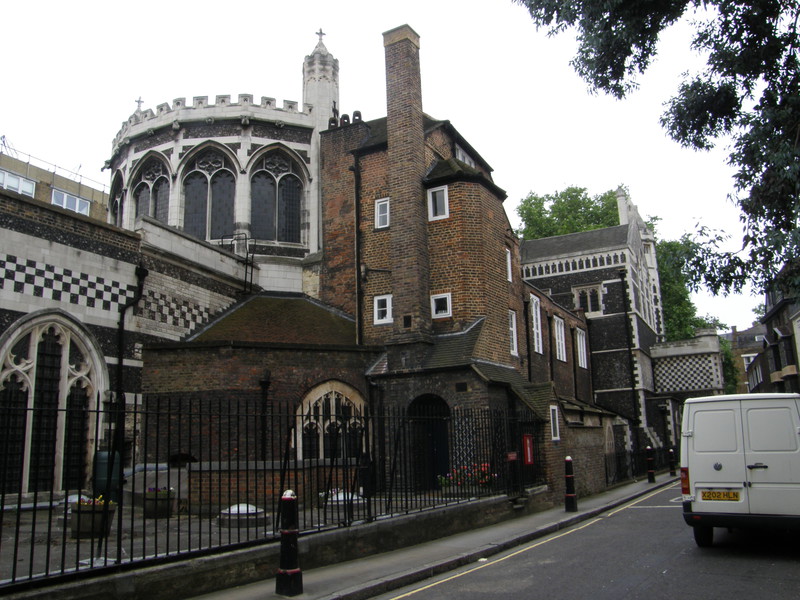
Not far from the Barbican is the church of St Bartholemew the Great, an early Gothic masterpiece, tucked away on a side street south of Smithfield Market. It's well worth the detour, and is simply charming, not least because it's so easy to miss. It's also a popular spot for office workers having a fag break; I can see the appeal.
I'll remember Smithfield Market for some time, though not because of the meat stalls (I was far too late to witness any activity) or the impressive buildings of the Central Market, which date from 1868. No, I'll remember it because just as I wandered into the market proper, I trod on a paving stone that gave way, spurting a jet of oily, black goo all the way up my left leg and down into my previously pristine white trainers. I've trodden on plenty of squirting paving stones in my time, but this was fetid, and I couldn't quite believe it; City folk flocked around, popping out for their mid-morning coffees, and there I was, suddenly scarred with tramp juice. Luckily the market itself is a great antidote to being doused with liquid offal, and even though it's a quiet place in the daytime, it must be quite a sight at 4am as the traders set up shop. I don't intend to find out, though; I'm not a morning person.
Farringdon station is just along Cowcross Street from the market, and this is where the real history of the Tube begins, for the oldest underground railway in the world was opened here on , joining Paddington to Farringdon along the Metropolitan line (though these first tunnels are actually used by the Hammersmith & City line these days). The station itself looks quite similar to Aldgate station, but being the original City tube station, it's just that little bit more impressive.
Farringdon to King's Cross St Pancras
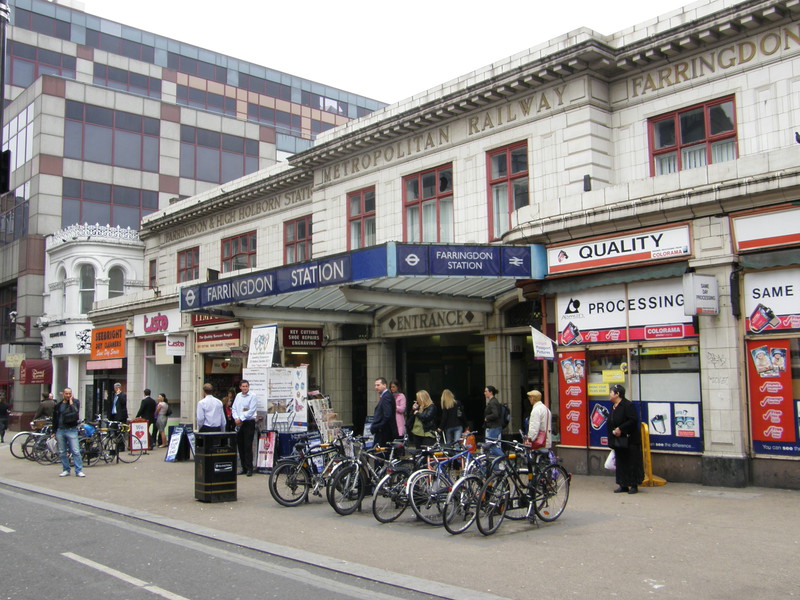
From Farringdon I walked north along St John's Lane, where the impressive stone St John's Gate spans the road before leading into Clerkenwell. It's subtle, but the atmosphere of the buildings starts to change, albeit slowly. There are some lovely mews round the back of St James's Church and some pleasant green spaces in Spa Fields Park and Wilmington Square, but it's a bit of a shock to reach King's Cross Road and the huge open area of the Mount Pleasant Royal Mail Sorting Office. It might date from 1889, but it feels as if you've fallen off the edge of the historical City and into a bland land of commerce and factory.
It's a similar story all the way to King's Cross St Pancras; the buildings aren't as polished as in the more affluent parts, but the redevelopment of this area is clearly having an effect, and there's no better demonstration than the new St Pancras International terminus. It's breathtaking, wandering into St Pancras and looking up at the newly restored roof and brickwork; it really feels like an international terminus, with platforms on two levels, a 9m-high statue of a couple of commuters getting fresh below the impressive station clock (the sculpture is called The Meeting Place)... and that incredible roof. It's brilliant.
King's Cross St Pancras to Euston Square

Not quite so brilliant is the spot a few blocks south of the British Library in Tavistock Square, site of the 7 July Bus Bomb. On an overcast Monday morning it's a peaceful spot, with a leafy garden in the centre of the square quietly minding its own business, and it must have been an incredible shock to see the roof being ripped off the number 30 at 9.47 in the morning. It's a strange feeling, watching double-decker buses driving over the very spot where, nearly three years ago, London was brought to a standstill.
The next station along the Metropolitan is Euston Square station. Initially I walked straight past it, and it was only when I spotted Warren Street station in the distance that I realised what I'd done... so I doubled back and crossed busy Gower Street to touch the walls of the station (which I'm doing at every stop). The station entrance is little more than a hole in the side of a building, as the front of the block is smothered in scaffolding and blocked off from public view, which could explain why I ignored it so comprehensively. No offence intended.
Euston Square to Great Portland Street
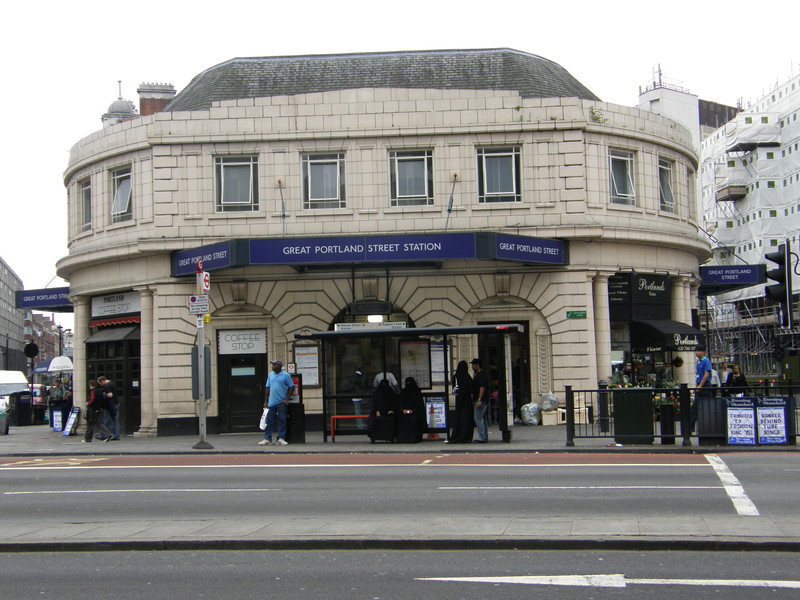
Much more obvious is Great Portland Street station, which sits alone at the northern end of Great Portland Street, after a short walk past the looming Euston Tower and the grand entrance to University College Hospital. The station is an oval building housing a restaurant, shops, a florist, subterranean toilets and the Tube station itself, like a Victorian shopping mall in miniature. I like it when Tube stations reveal themselves; it's normal in the suburbs, but in the centre of town, they're so often incorporated into other buildings, or completely hidden underground. Good for Great Portland Street, then, for standing alone on such a busy junction.
Great Portland Street to Baker Street
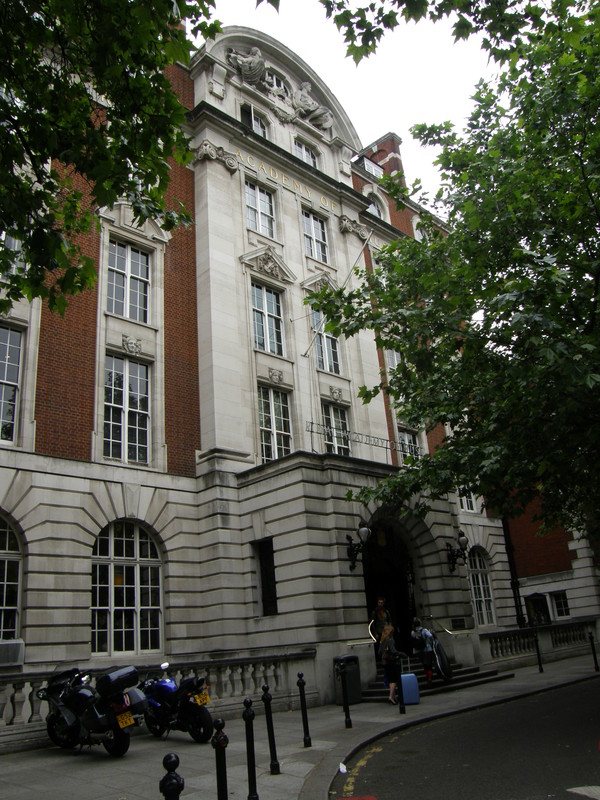
From Great Portland Street to Baker Street, I followed Marylebone Road with a strong sense of déjà vu, as until Friday this was my commuting route. It might not strike the casual walker as an interesting road to follow, but this entire road was ripped up to build the original Metropolitan line, so in a very real sense the road itself is part of the world's first subterranean railway. Charles Dickens lived at 1 Devonshire Terrace (now 15-17 Marylebone Road) from 1839 to 1851, where he wrote The Old Curiosity Shop, Barnaby Rudge, Martin Chuzzlewit, A Christmas Carol, Dombey and Son, and David Copperfield; and just before Baker Street station you have to fight your way through the tourist chaos outside Madame Tussauds, which is always fun when you're commuting with sharpened brolly in hand. Madame Tussauds now incorporates the old Planetarium, one of my favourite little buildings in the city, with its little Saturnine planet plonked on the top like the architectural equivalent of a springy table tennis antenna hat. It reminds me of the cover to the Pixies' Bossanova, which is a good memory, and every time I go past, I secretly hope it will shake its dome and bounce its antennae around like the mischievous child I imagine it to be. I'm still waiting, but I'm waiting in hope.
Baker Street to Finchley Road
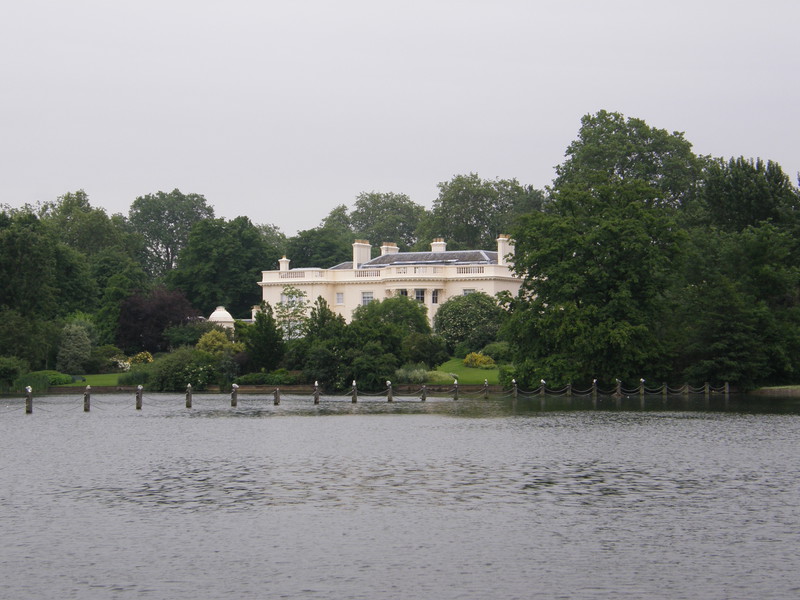
Buried deep in the large building on the corner of Baker Street and Marylebone Road is Baker Street station, the last of the original stations from the first section of the 1863 Metropolitan line (the line actually went on to Paddington, but this part is no longer part of the Metropolitan, but the Hammersmith & City). The station itself is decked out in tiling showing the pipe-smoking profile of Sherlock Holmes, whose fictitious address of 221b Baker Street is just round the corner. It's now home to a Sherlock Holmes museum and shop, of course, and is just up the block from a Beatles store and opposite a rock 'n' roll memorabilia emporium. Holmes would probably approve, and might even deduce that this is a prime tourist spot.
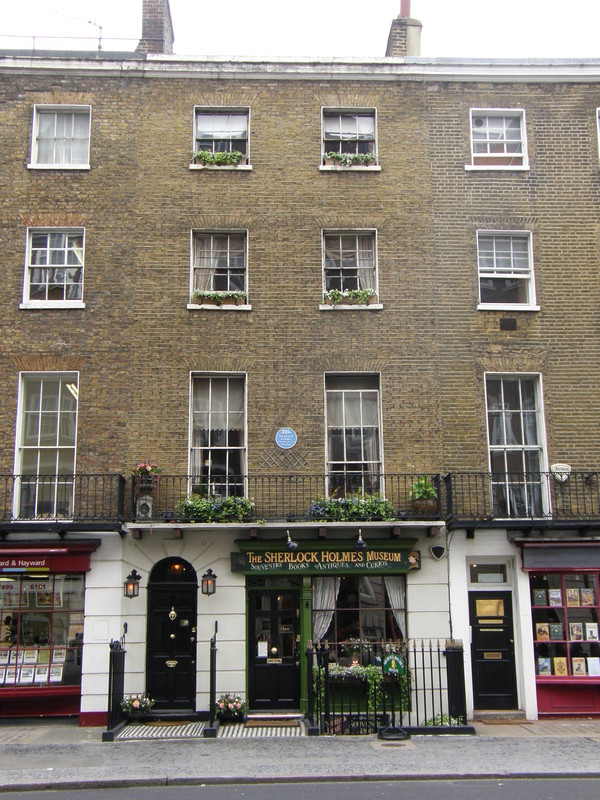
It's a short hop across a pedestrian crossing to Regent's Park, one of my favourite London parks. I'm going to be visiting the park again on my Bakerloo walk, so today's jaunt only took in the western and northern reaches of the park, including the lovely boating lake, with its landscaped views across to the private residence of The Holme (jealous? hell, yes). Unfortunately the rain that started dribbling down at Great Portland Street suddenly turned up the volume, leaving this part of the park looking far from its best, but further north the park spreads out into playing fields with wide horizons, and if you're going to walk through the rain, this is the way to do it. Stranded in the middle of these fields is The Hub, a café perched on an earth mound with a 360° view of the park; normally it's a great spot for a lazy coffee, overlooking the football matches and dog walkers, but I'm afraid I shot past, aiming for the relative dryness of the Tube.
Even more disappointing in the rain is the panoramic view from Primrose Hill, though it's still impressive to see London laid out before you, the City to the left and the BT Tower dominating the centre of town. On a sunny day, Primrose Hill is one of the best views in London; on a day like today, it's windswept, lonely and arguably more atmospheric, though it's easy not to dawdle.
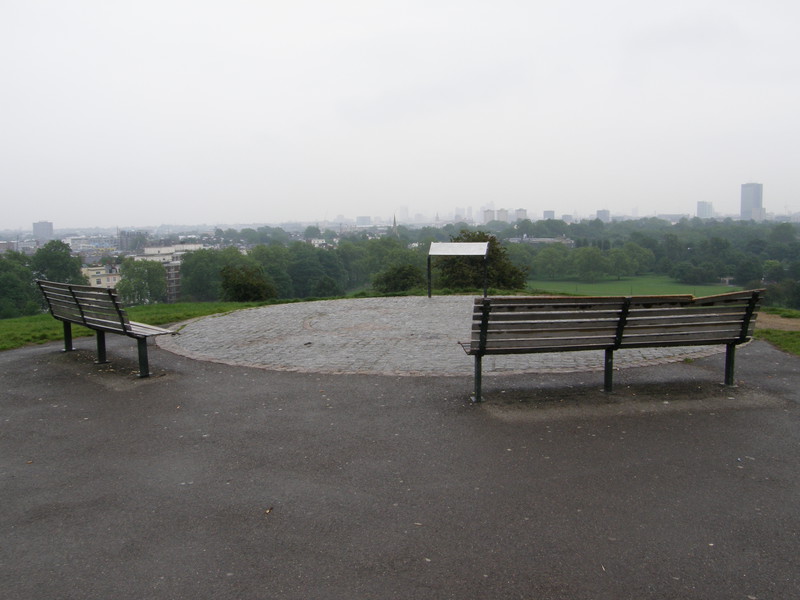
Heading down from Primrose Hill, it's almost like stumbling into an architectural face-off. The houses at the base of the hill are gorgeous and full of character, but it doesn't last, because on the northern side of King Henry's Road, the old stone houses give way to much more modern fare, and it's quite a contrast. Rising in the near distance are tower blocks whose window mould you can sense even from this distance, and Finchley Road is a similar mix of the lovely and the unloved, all the way to Finchley Road station, at the end of this leg.
So that's day one done and dusted, and what a great walk. Indeed, the only problem with a walk this varied is fitting it all in; I was forever pulling out the camera and snapping away while trying to balance an umbrella and maps in the other hand. If this is a taste of things to come, I'm a very lucky person to be spending the next three months walking the Tube. Bring on the summer weather!